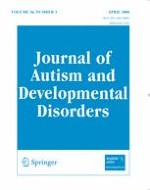01-04-2006
Normal Physiological Emotions but Differences in Expression of Conscious Feelings in Children with High-Functioning Autism
Gepubliceerd in: Journal of Autism and Developmental Disorders | Uitgave 3/2006
Log in om toegang te krijgenAbstract
To provide insight into what aspects of the emotional circuit might be affected in high-functioning autism, we measured indices of physiological emotions and of the expression of conscious feelings in 10 children with high-functioning autism or Asperger syndrome and 10 comparison participants. Pleasant, unpleasant, and neutral pictures were presented while skin conductance responses were measured. Self-report ratings of pleasantness and interestingness were taken between pictures. Skin conductance responses did not differ between the groups. Self report ratings were different, with the children with autism giving more similar answers to the two questions than the comparison children. Impairments in socio-emotional expression in autism may be related to deficits in perception and/or expression of conscious feelings; physiological emotions may be relatively preserved.
